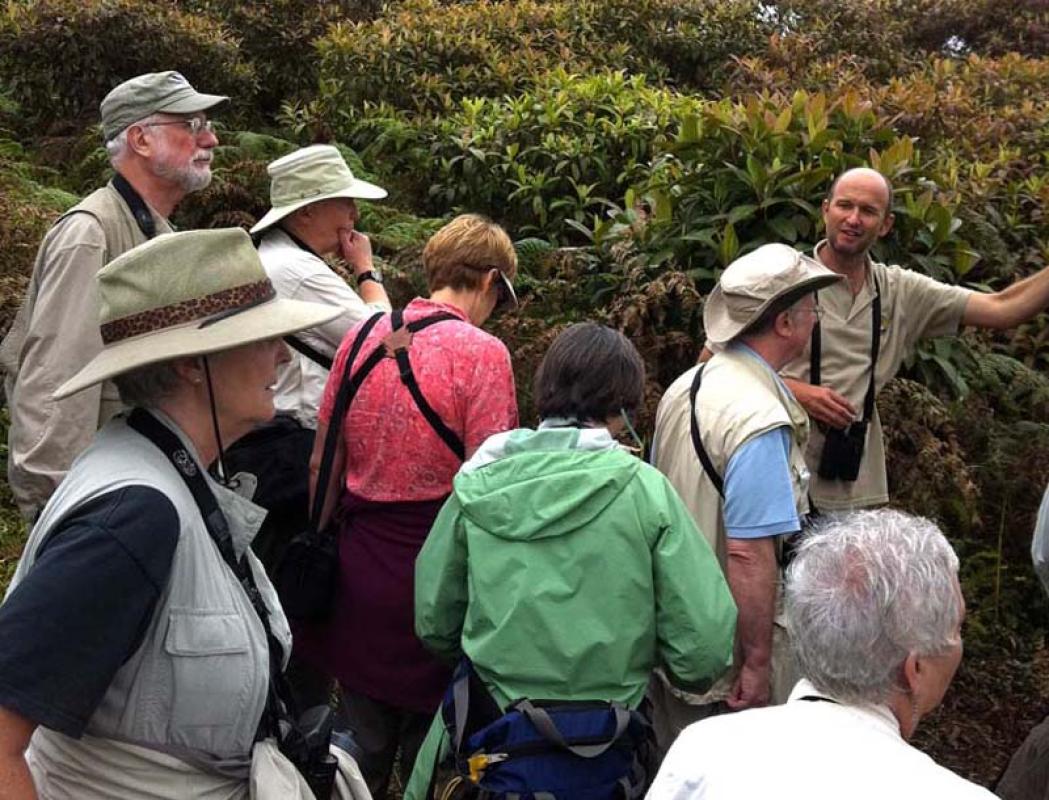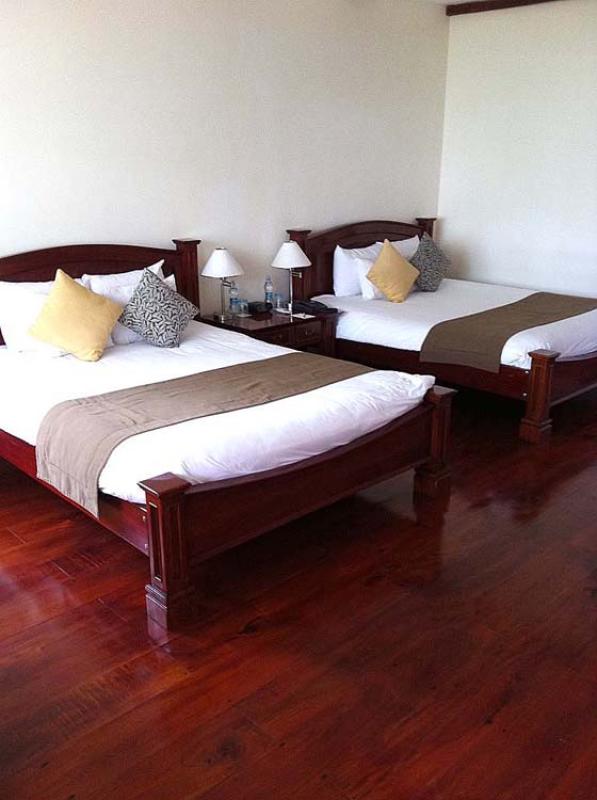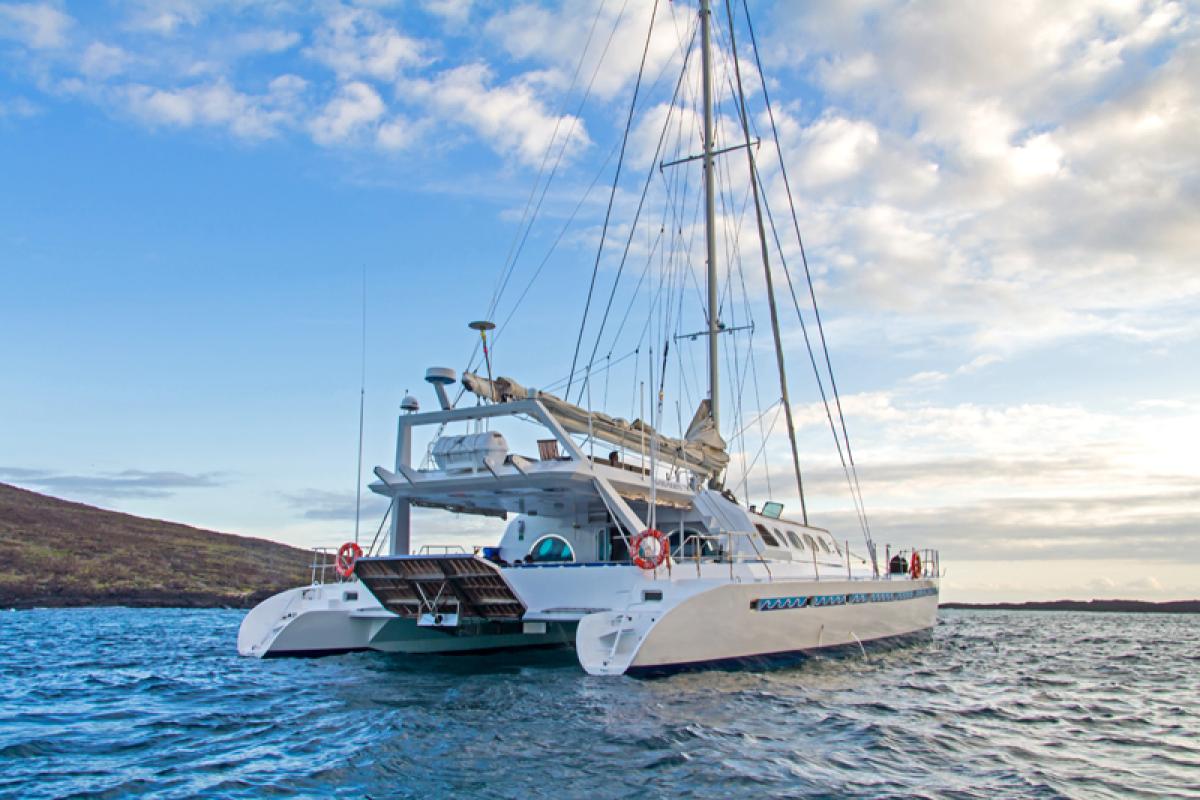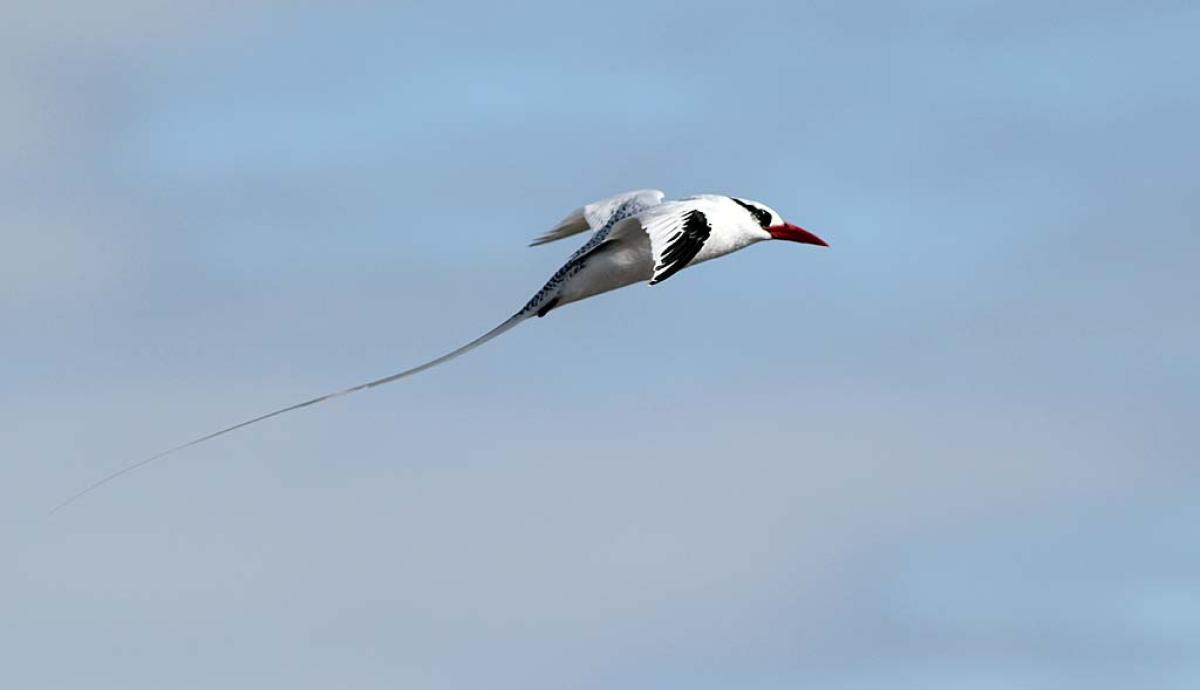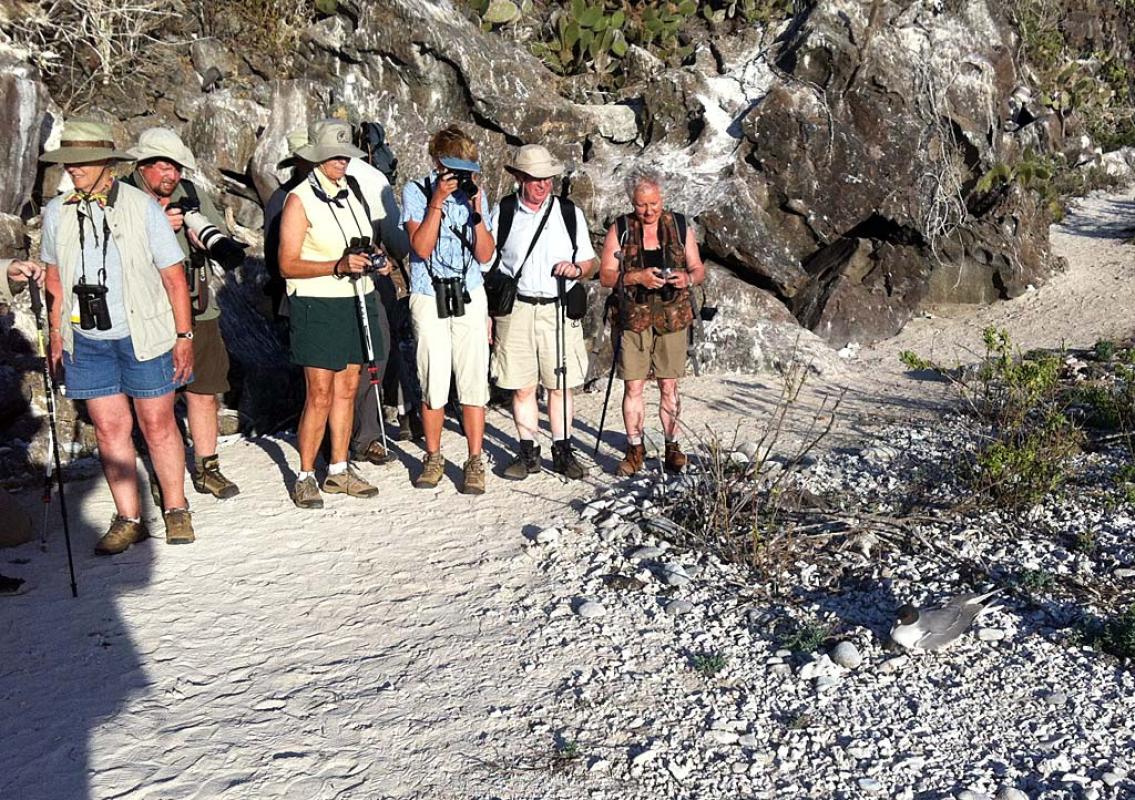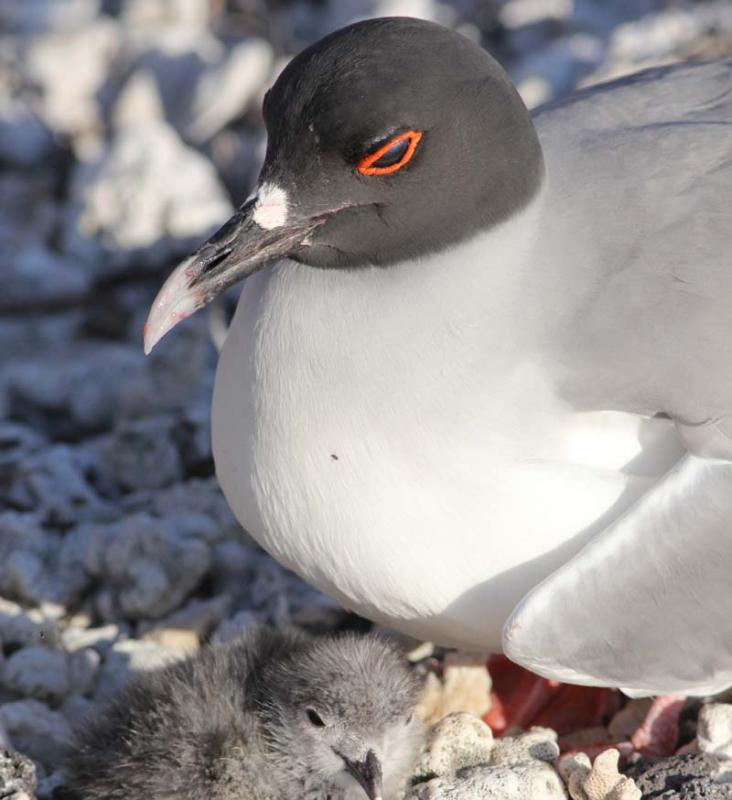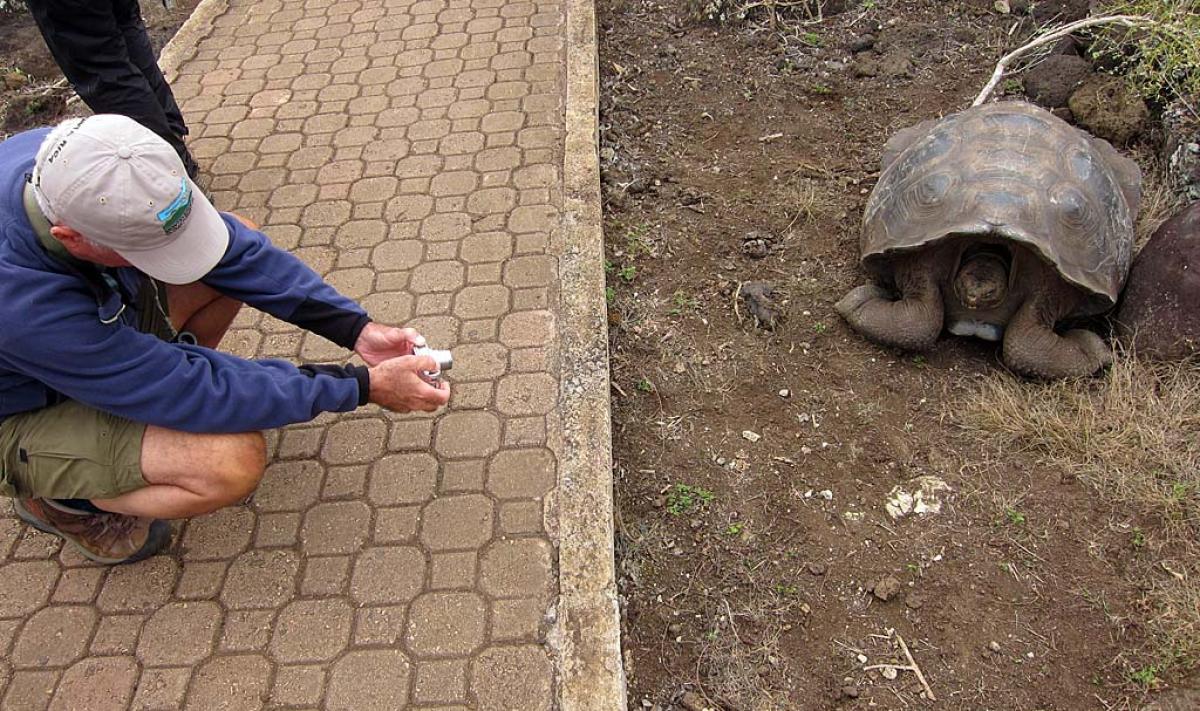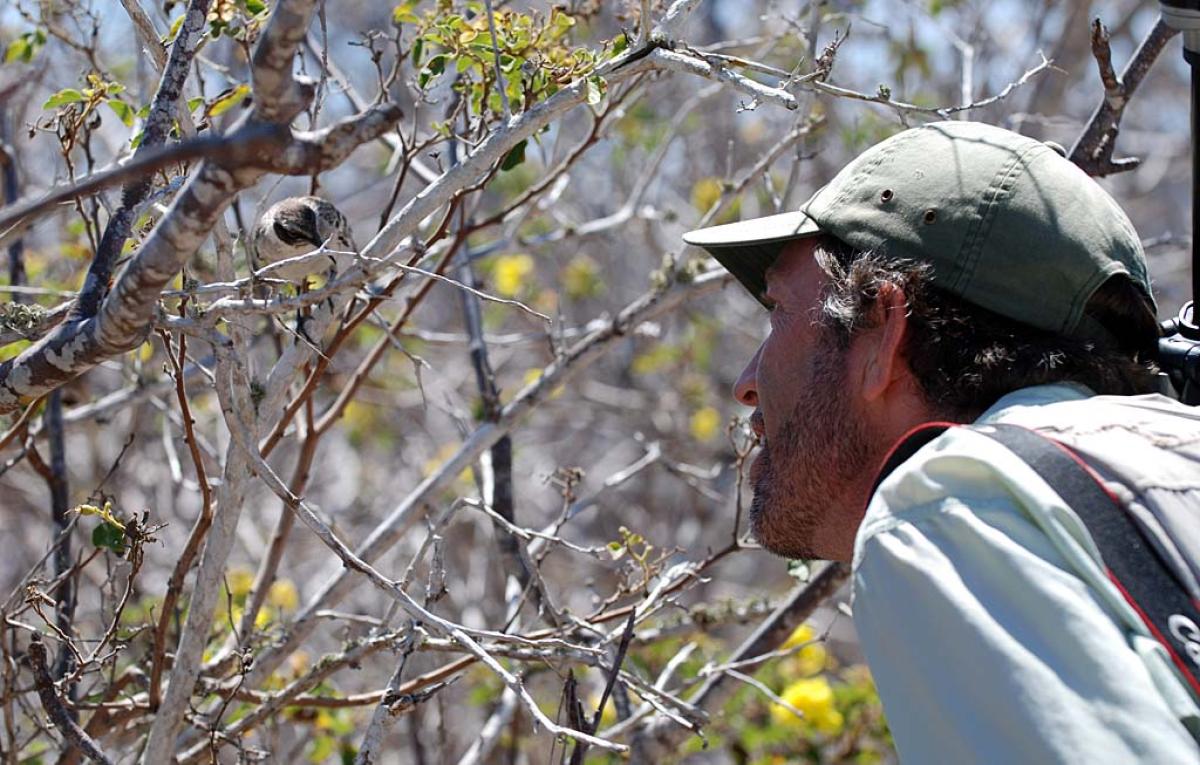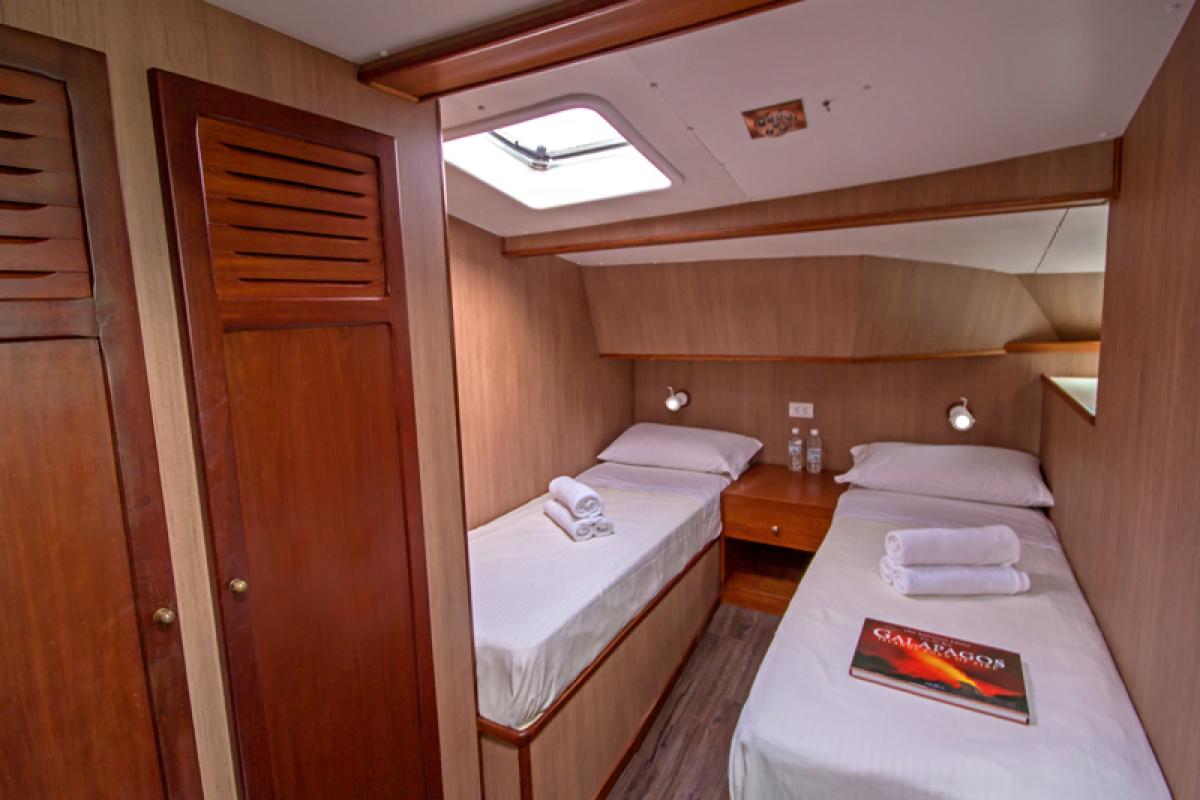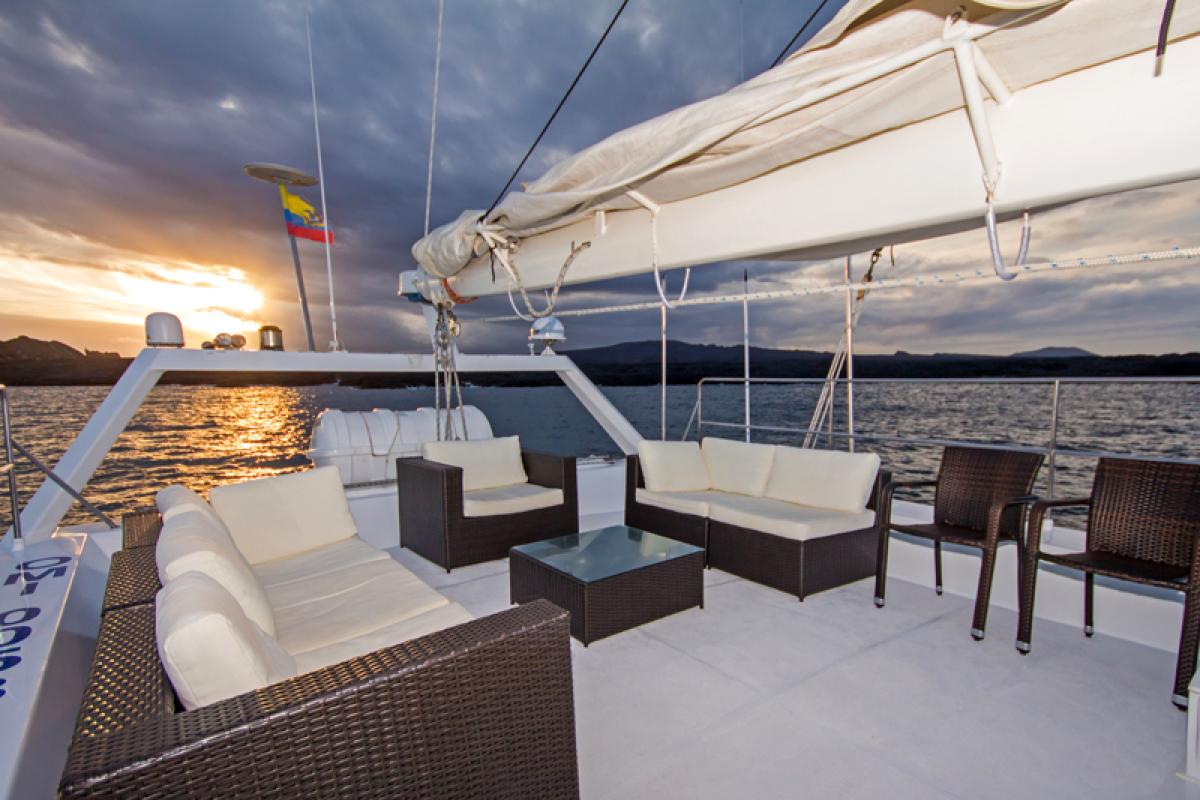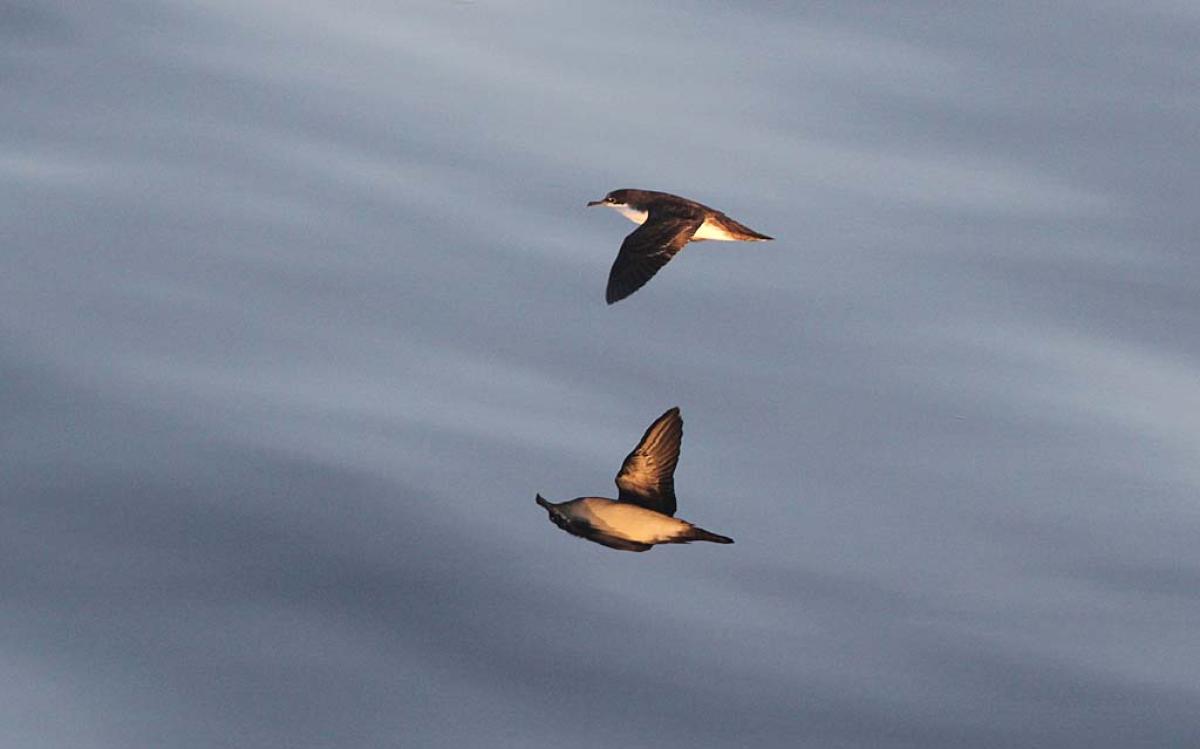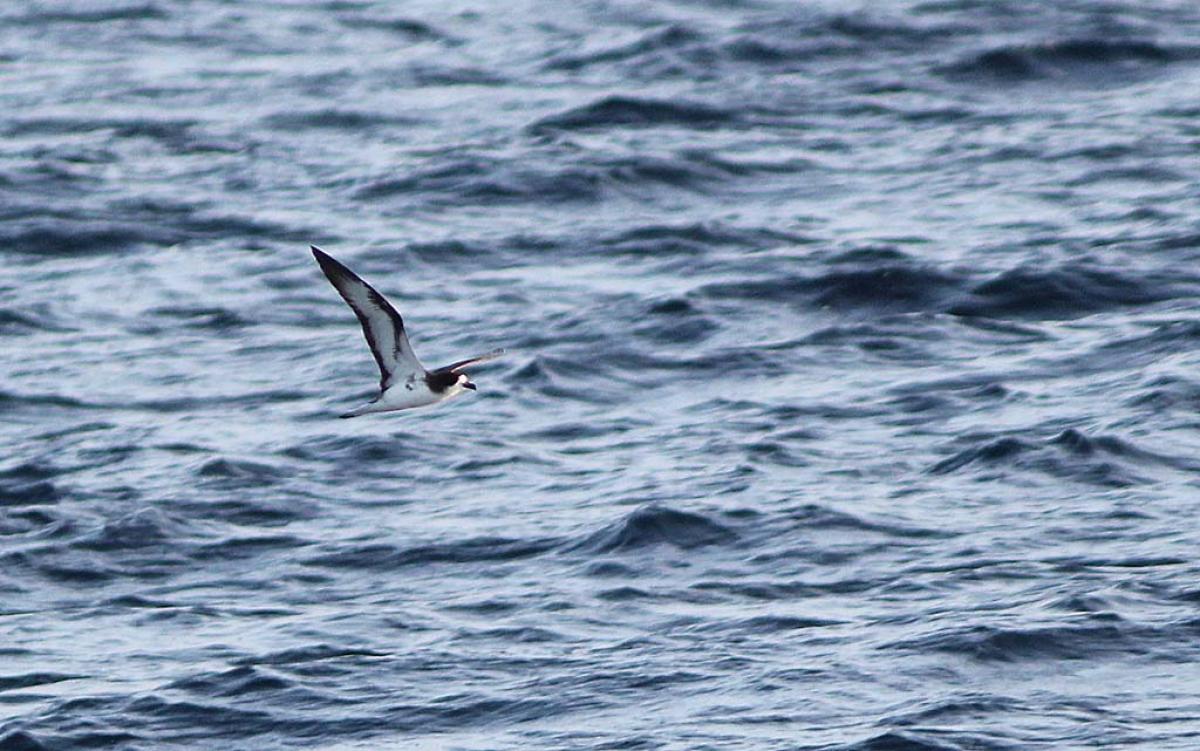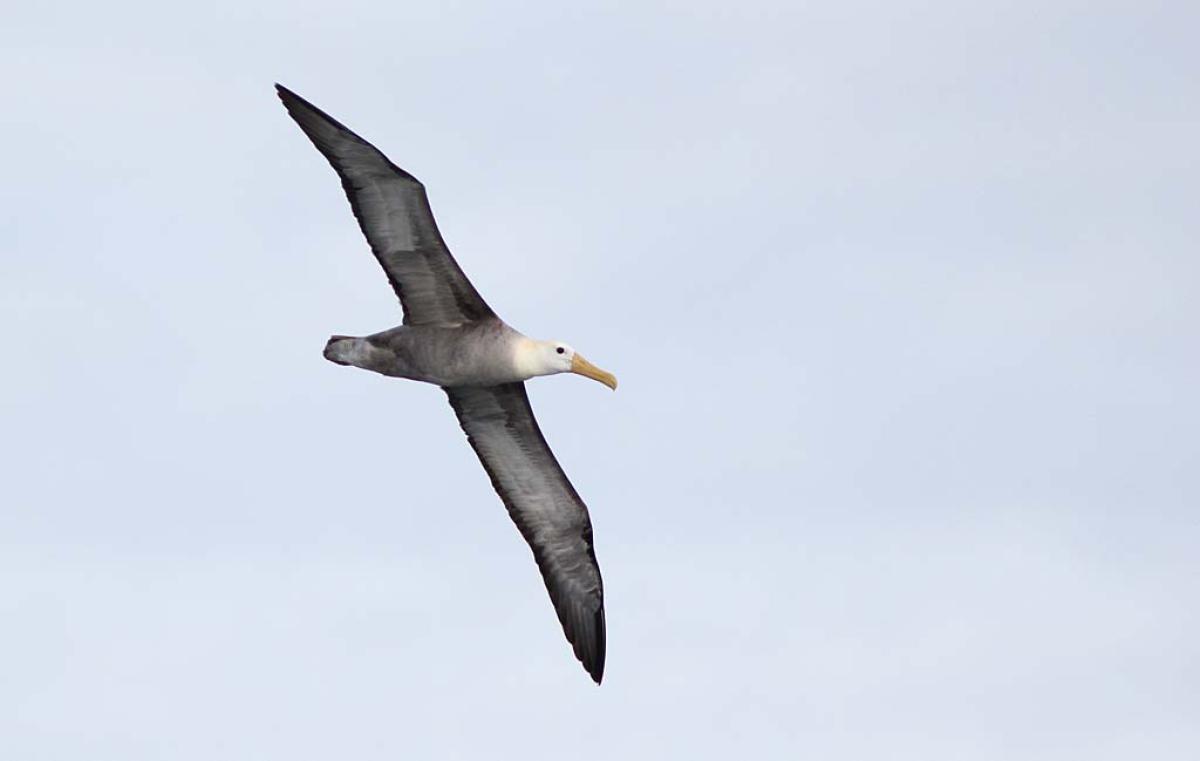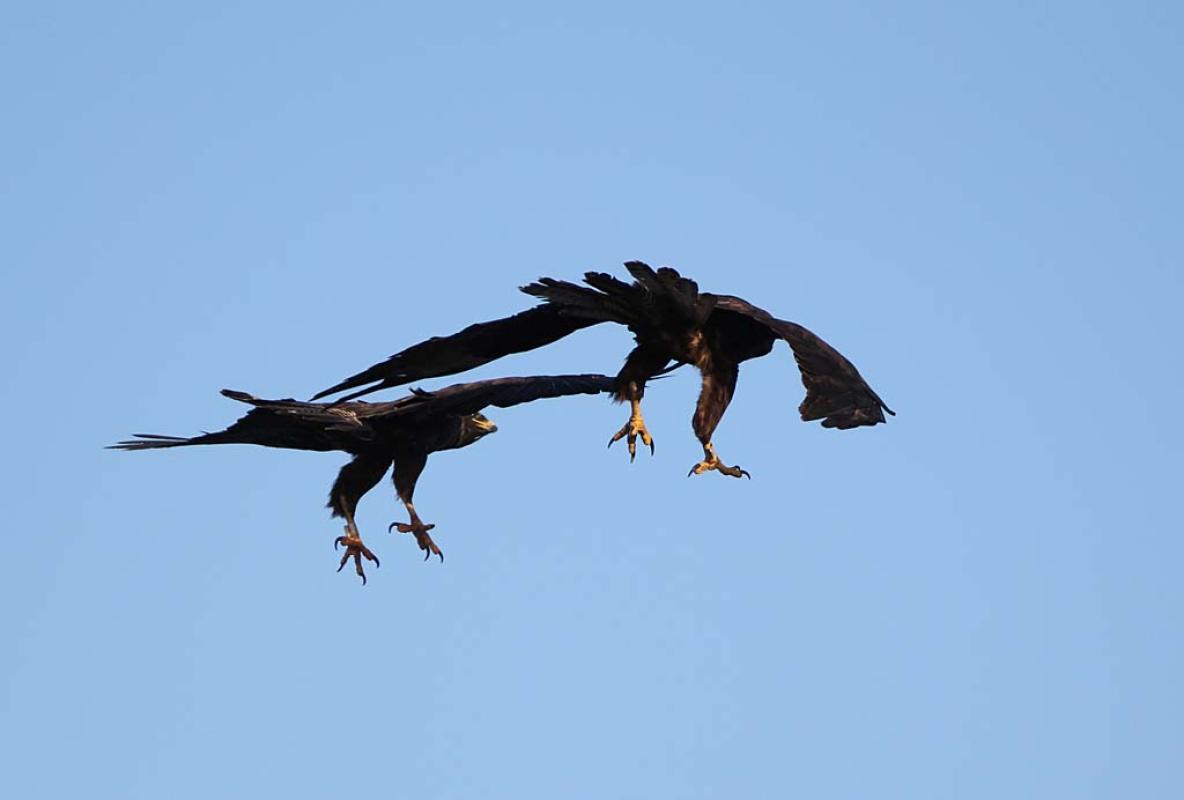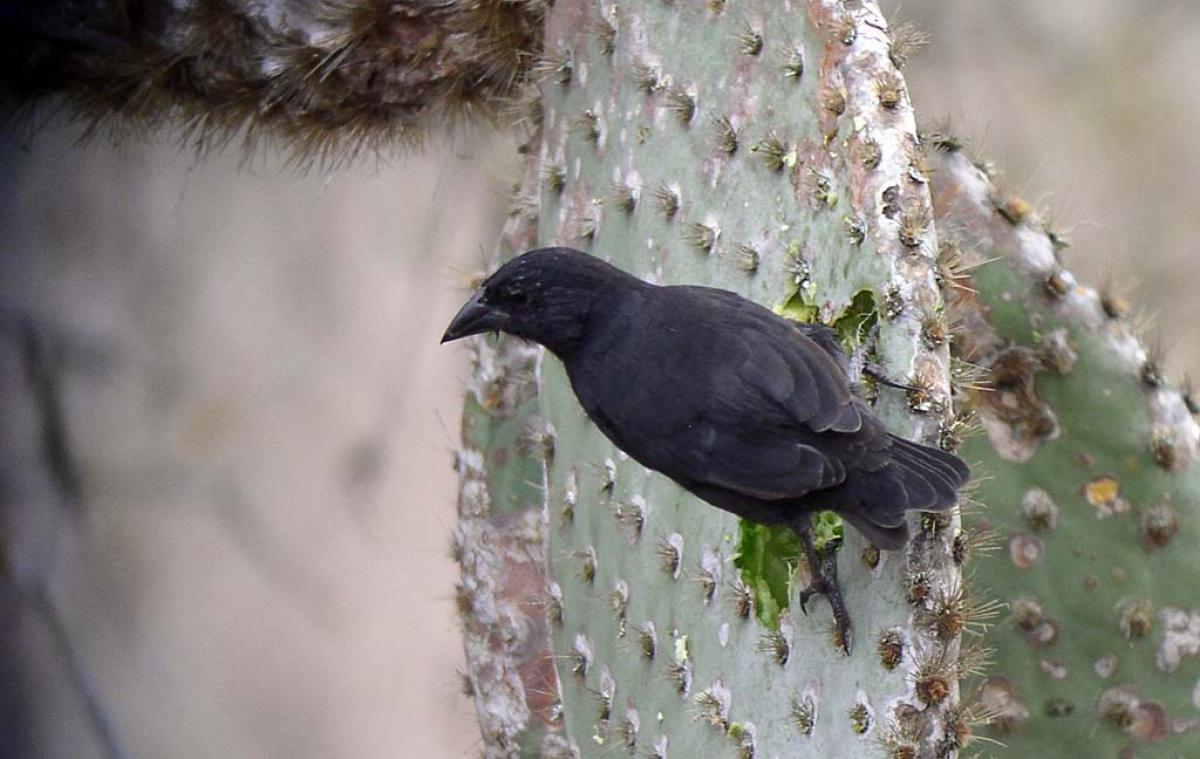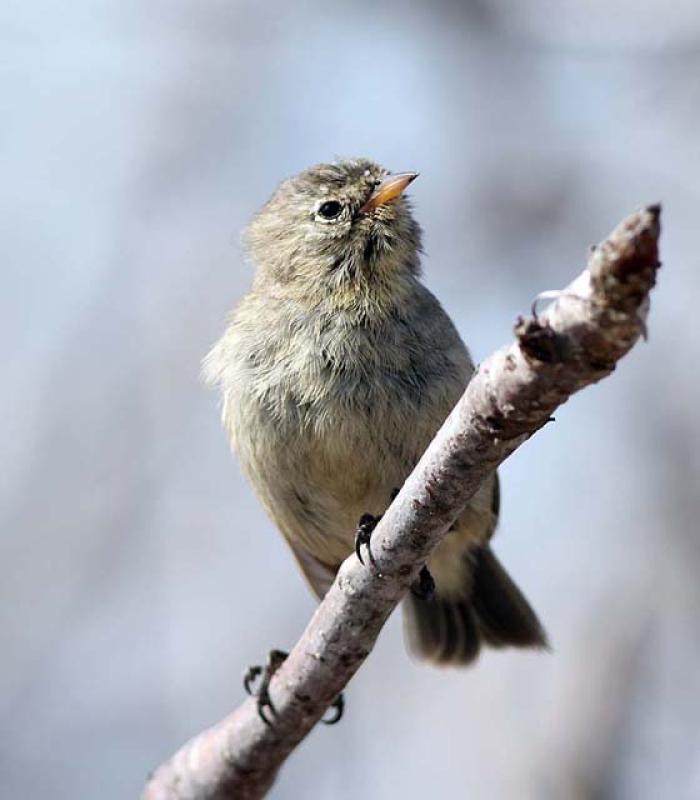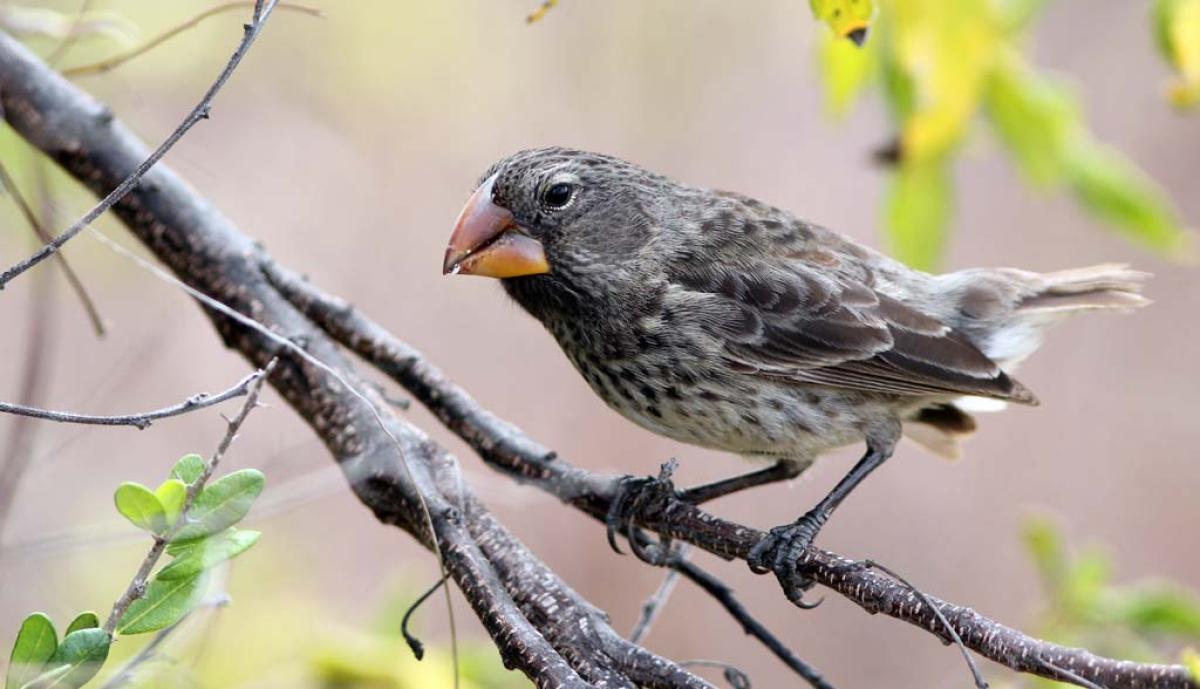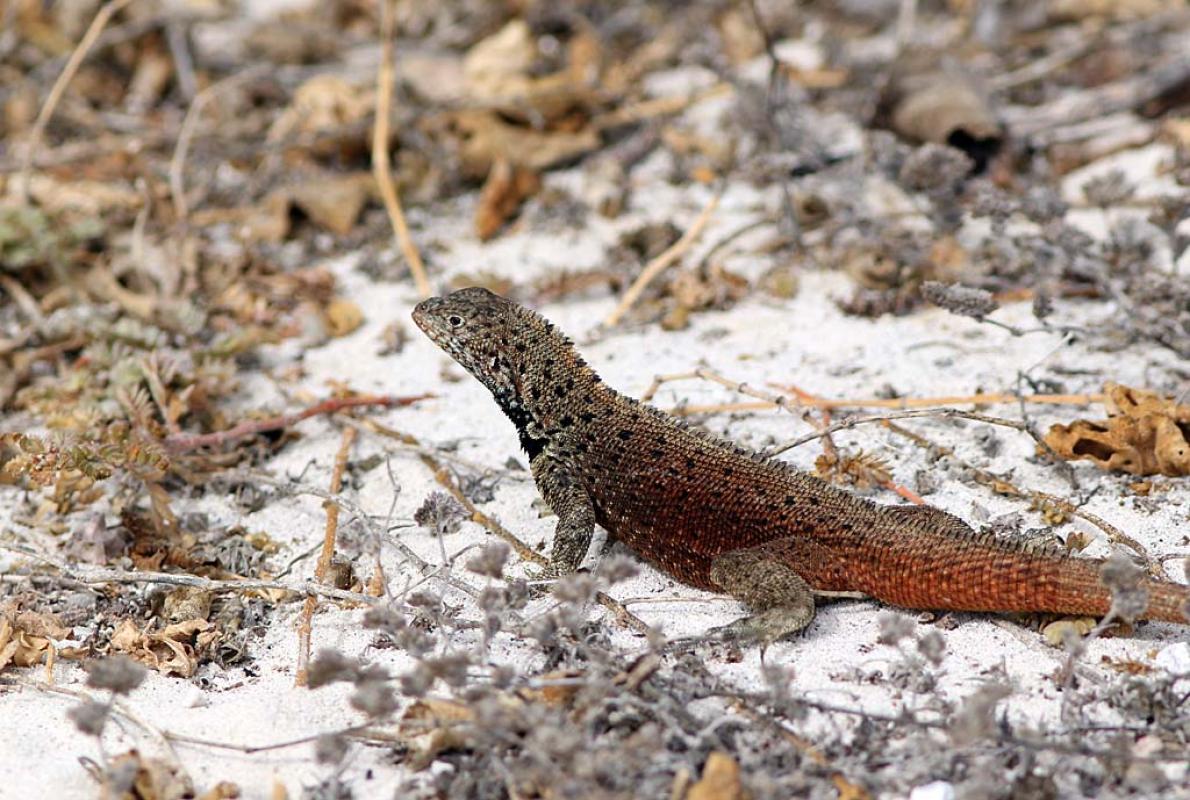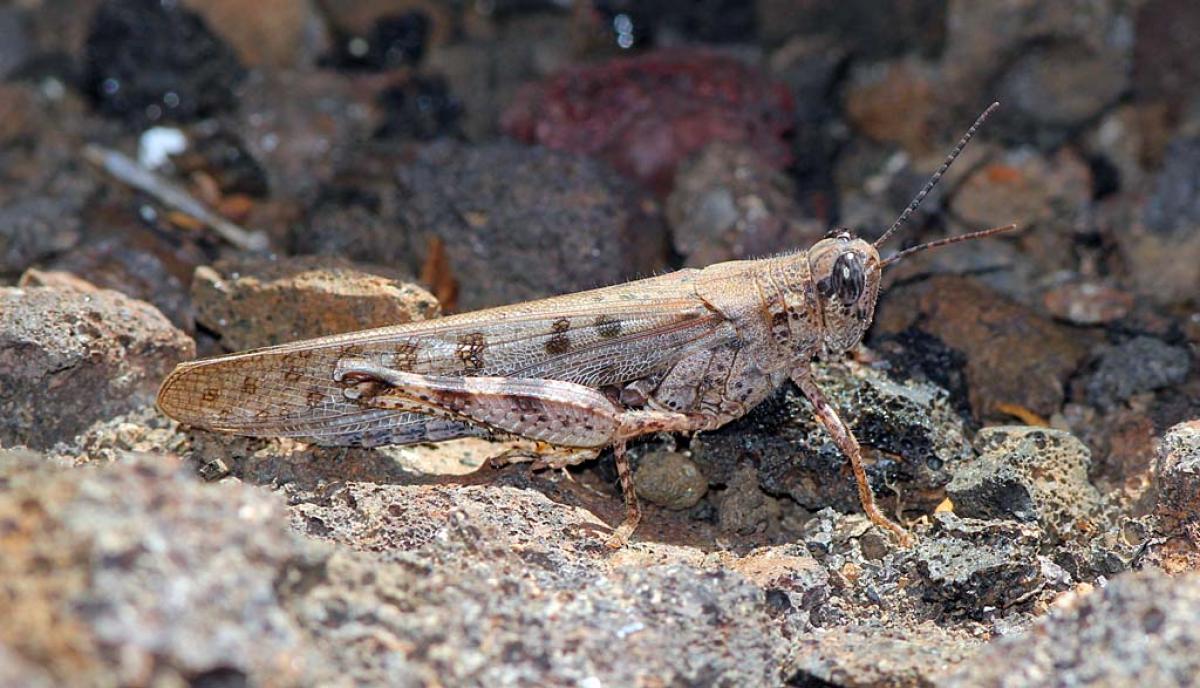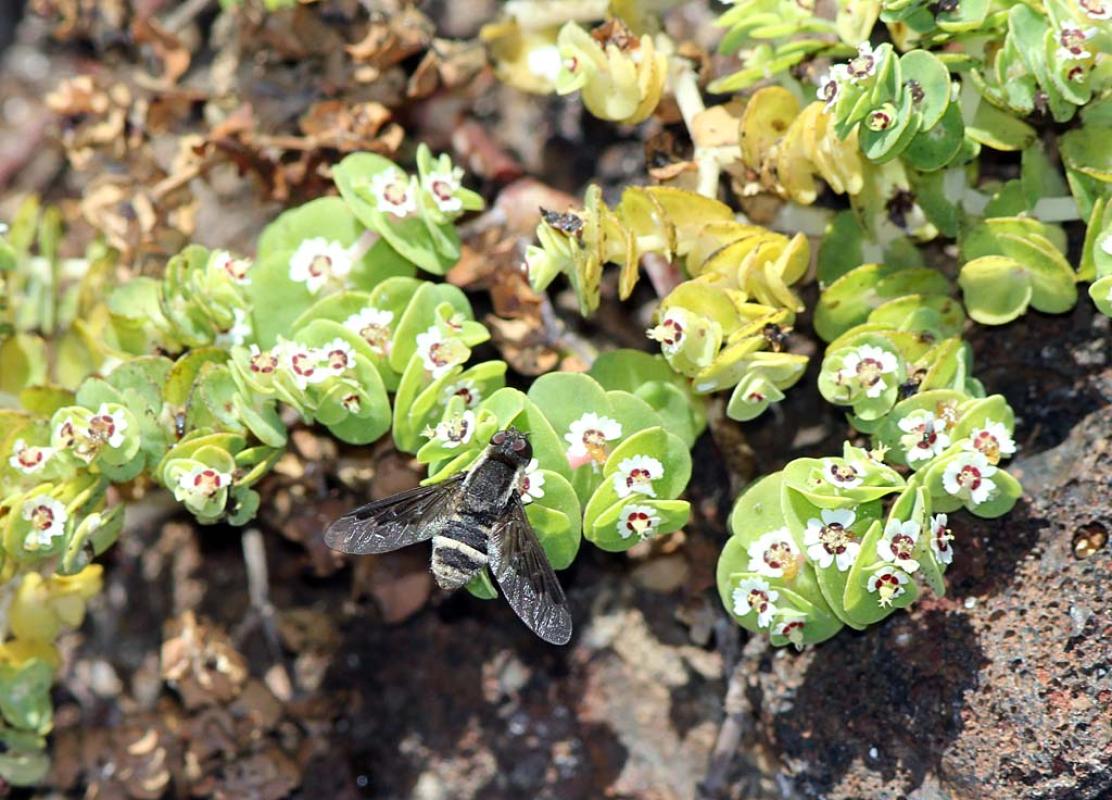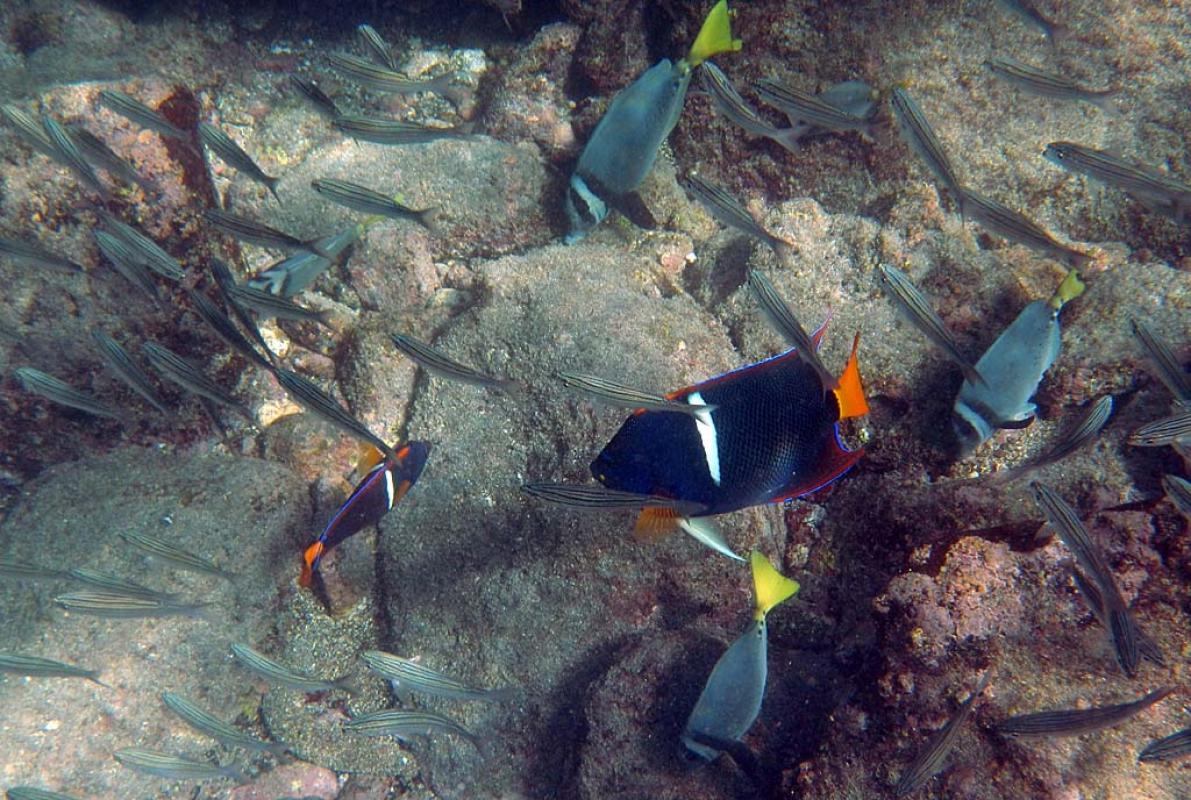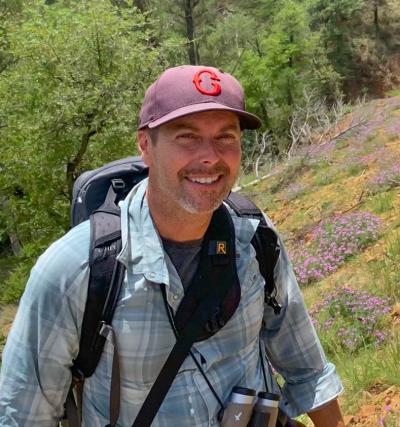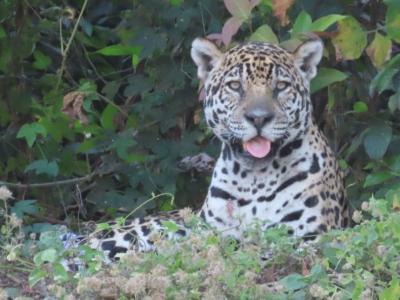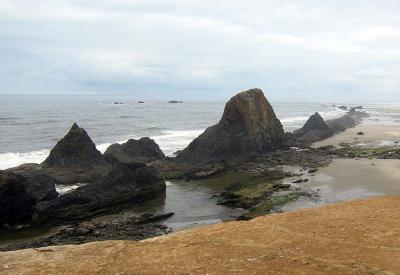The Galápagos Islands
-
May 29 to Jun 8 2026
Rich Hoyer
-
Jun 25 to Jul 5 2027
Rich Hoyer
2026
For single occupancy, please contact the WINGS office.
2027
Tour Price to be Determined
2026
For single occupancy, please contact the WINGS office.
2027
Tour Price to be Determined
The Galápagos Islands were born out of the bowels of the earth millions of years ago as intense volcanic activity spewed forth lava and buckled the seabed. The resulting archipelago, some 600 miles off the coast of Ecuador, now straddles the equator, scattered far and wide by the slow movement of tectonic plates within the earth’s crust. This isolation, from both continental South America and each other, has given each island a unique character. As wildlife colonized the islands, it began a process of adaptation to the specific conditions, and Charles Darwin’s observations here during his voyage on the Beagle helped crystallize his epic theory. Today one can still see virtually all the creatures Darwin did—a mind-boggling array of fascinating, fearless, and endemic birds and other animals.
The Ecuadorian government carefully controls visits to the Galápagos, and though the restrictions keep prices high, they also ensure that only a very limited number of boats can visit at one time. We’ve chartered a fine boat, the sea catamaran Nemo III, following an itinerary with natural history exploration in mind. In addition to seeing as many of the endemic birds as we can (among which are a couple of gulls, 14 of the 17 finches, two flycatchers, four mockingbirds, a dove, a penguin, a cormorant, a rail, and a martin), we’ll have plenty of chances to spend time with the storied seabirds, sea lions, and marine iguanas, as well as the many other endemic species worth looking for, including lizards, a few small snakes, a butterfly, a dragonfly, and even a scorpion and a few spiders, moths, and others. We’ll also have almost daily opportunities for snorkeling among the abundant sea life, from schools of colorful fish to sea turtles.
The 2026 Galapagos tour can also be combined with our Ecuador: NW Andes in Summer trip.
The Galápagos Islands were born out of the bowels of the earth millions of years ago as intense volcanic activity spewed forth lava and buckled the seabed. The resulting archipelago, some 600 miles off the coast of Ecuador, now straddles the equator, scattered far and wide by the slow movement of tectonic plates within the earth’s crust. This isolation, from both continental South America and each other, has given each island a unique character. As wildlife colonized the islands, it began a process of adaptation to the specific conditions, and Charles Darwin’s observations here during his voyage on the Beagle helped crystallize his epic theory. Today one can still see virtually all the creatures Darwin did—a mind-boggling array of fascinating, fearless, and endemic birds and other animals.
Visits to the Galápagos are carefully controlled by the Ecuadorian government, and though the restrictions keep prices high, they also ensure that only a very limited number of boats can visit at one time. We’ve chartered a fine boat, the sea catamaran Nemo III, following an itinerary with natural history exploration in mind. In addition to seeing as many of the endemic birds as we can (among which are a couple of gulls, 14 of the 17 finches, two flycatchers, four mockingbirds, a dove, a penguin, a cormorant, a rail, and a martin), we’ll have plenty of chances to spend time with the storied seabirds, sea lions, and marine iguanas, as well as the many other endemic species worth looking for, including lizards, a few small snakes, a butterfly, a dragonfly, and even a scorpion and a few spiders, moths, and others. We’ll also have almost daily opportunities for snorkeling among the abundant sea life, from schools of colorful fish to sea turtles.
Day 1: Our Galapagos Islands tour begins this evening with a briefing about our upcoming cruise among the islands made famous by Charles Darwin. Night in Quito.
Day 2: We’ll fly this morning to Baltra, but before noon we’ll be seeing our first island endemics, including Medium Ground-Finch around the Baltra airport, Galapagos Sea Lion, and many species of endemic plants. We’ll make an official stop in the interior of the island of Santa Cruz within the protected national park, as well as some visits to private ranches, before we check in to our comfortable hotel. Night on Santa Cruz.
Day 3: We’ll continue our birding in the highlands of Santa Cruz. One of our targets is the tiny Galapagos Rail, a species whose highland habitat is readily accessible only here. We’ll likely need more time to look for less common finches such as the Vegetarian Finch and the declining Large Tree-Finch. Later we’ll descend to the town of Puerto Ayora for some time in the shops for postcards and gifts. Before dinner we’ll board our boat. Night aboard the S/C Nemo III.
Days 4-9: Each of these days will feature a different island. Typically, we’ll arrive at our island of the day in the early morning, waking up to a new and exciting place. After a complete breakfast on board, we’ll depart in the Zodiacs for a short hike to view the island’s specialties. Depending on the length of our hike, we’ll either return to the boat for our daily snorkeling opportunity or head immediately to lunch and a siesta followed by an afternoon snorkeling option. We’ll motor to a different part of the same island or to a nearby island for an afternoon hike of a different nature.
Each of the islands has its own highlights, and here are brief descriptions of some we hope to visit, pending final approval of our itinerary.
Baltra is a low, flat island, once a U.S. military base and overrun with goats; it’s now goat-free, vegetation has rebounded tremendously, and native wildlife is again common. This is also the location of the larger of two main airports, where we begin our tour.
Santa Cruz, the second-largest of the islands, hosts the largest human settlement, Puerto Ayora, and is immediately south of Baltra, separated by a narrow channel. Our stay here will feature a visit to a Giant Tortoise sanctuary where wild tortoises still roam. We may also visit the Darwin Research Center to see the breeding program for all other races of the tortoise.
North Seymour is another low island, just to the north of Baltra, and is popular for the large colonies of ground-nesting Blue-footed Boobies and bush-nesting Magnificent Frigatebirds (with a few Great Frigatebirds for comparison).
San Cristóbal is home to its own species of mockingbird as well as several finch species.
Santa Fé is a small island that is home to its own endemic species of Land Iguana, as well as Galapagos Hawk and Common Cactus-Finch. The small bay where we anchor has easy snorkeling, with usually very calm waters and varied substrate.
Bartolomé and its satellite islands is where we’ll have the chance to see Galapagos Penguin (and swim among them), as well as view the iconic peak at sunset. Tidepooling is at its best here, and the scarce Galapagos Fur Seal has a small colony on the island.
Española will provide one of our most memorable visits, for this is where the colony of Waved Albatrosses is located. Galapagos Hawk, the shockingly inquisitive Española Mockingbird, Gray Warbler-Finch, and many other creatures are easily seen here as well.
Floreana is home to the historic Post Office Bay and offers a good chance for American Flamingos, while the satellite islet of Campeón harbors the only population of Floreana Mockingbirds and provides some of the most exciting snorkeling in the islands.
Isabela is the largest island and has the most reliable populations of Brujo Flycatcher and an accessible, if small, colony of Galapagos Martins.
Fernandina is the westernmost and youngest island where lava flows dotted with the endemic Lava Cactus seem to have formed only days ago. The snorkeling here could include sighting Marine Iguanas grazing on the underwater algae beds.
Day 10: This morning we’ll awake in the harbor of Baltra, where we’ll say farewell to the Nemo III crew and transfer to the airport for the flight back to Quito. Night in Quito.
Day 11: Our Galapagos Cruise concludes this morning in Quito.
CANCELLATION & REFUND POLICY FOR GALAPAGOS ISLANDS CRUISE: Payment: A 10% deposit is due at time of booking. The tour will be invoiced at 140 days and final payment is due 125 days prior to departure. Cancellation: If cancelling up to and including 140 days prior to departure the deposit – less the non-refundable amount of $200 - and any payments are refundable. If we receive the cancellation 140 – 120 days prior to departure the deposit is not refundable but any payments against the balance of the tour price will be returned. The full expedition fee is forfeited if your notice of cancellation is received within 120 days of your departure date.
ENTERING & LEAVING ECUADOR: Ecuadorian authorities require a passport that is valid for at least six months after your date of arrival in Ecuador. Visas are not currently required for U.S. and Canadian citizens. Tourist cards are prepared by your arriving airline. In the recent past, there was a $40.80 departure tax in Ecuador however most major airlines now include this in the price of your international ticket. If your airlines does not include this in your ticket please be prepared to pay with cash.
Note: A certification of yellow fever vaccination is required by Ecuadorian authorities if you are entering Ecuador from a country where yellow fever is present (check with your local public health agency or the Centers for Disease Control for this list); if you are entering Ecuador from the US this is not required (but see below under HEALTH).
COUNTRY INFORMATION: You can review the U.S. Department of State Country Specific Travel Information here: https://travel.state.gov/content/travel.html. Review foreign travel advice from the UK government here: https://www.gov.uk/foreign-travel-advice and travel advice and advisories from the Government of Canada here: https://travel.gc.ca/travelling/advisories.
PACE OF THE TOUR: Participants should expect moderately early starts with a warm breakfast at 6:30 a.m., followed by a morning walk on land. Lunches and dinners will be on the yacht, while meals before and after the cruise will be in restaurants. Land-based excursions in the Galápagos are on trails, often with extremely rough footing, such as uneven rocks and sharp lava flows. A collapsible hiking stick or two is recommended for anyone with balance issues.
If in the course of the trip you are concerned about your ability to do any particular hike or activity, please consult the leader before you start. We have structured our itineraries in ways that permit you to skip a planned activity if you choose. Please note that the leaders have the responsibility (and the authority) to require any passenger to remain in the vehicle or on board the yacht whenever the guide believes that a passenger’s health and/or physical ability makes that activity a substantial risk to his/her well-being, or would limit the enjoyment of the activity by the other trip members.
Snorkeling, optional and always in the company of the local guide and attendant zodiac, will be an almost daily activity in the late morning or early afternoon for about an hour. The water is not cold, but in some places can be on the chilly side for an equatorial region, so a 3 mm shorty wetsuit is recommended, as is bringing a personal-fit mask and snorkel. The boat provides these as well, but bringing your own insures a better fit. Hardier souls find the water tolerable in a simple swimsuit and shirt. The boat has a good selection of flippers for our use.
HEALTH: The Centers for Disease Control and Prevention (CDC) recommends that all travelers be up to date on routine vaccinations. These include measles-mumps-rubella (MMR) vaccine, diphtheria-tetanus-pertussis vaccine, varicella (chickenpox) vaccine, polio vaccine, and your yearly flu shot.
They further recommend that most travelers have protection against Hepatitis A and Typhoid. Please contact your doctor well in advance of your tour’s departure as some medications must be initiated weeks before the period of possible exposure.
The most current information about travelers’ health recommendations can be found on the CDC’s Travel Health website here: https://wwwnc.cdc.gov/travel/destinations/list
Yellow Fever: Certification of yellow fever vaccination is not required unless you are entering Ecuador from a country where yellow fever is present (check with your local public health agency or the Centers for Disease Control for this list); if you are entering Ecuador from the US, this is not required. The CDC, however, is currently recommending yellow fever vaccination for travelers to Ecuador who plan to be outside of urban areas.
Malaria: The Centers for Disease Control and Prevention do not recommend a malarial prophylaxis for the areas we will be visiting, as there have been no recent cases of the disease. You may want to consider following the CDC’s precautions if visiting the Amazonian region of Ecuador before or after the cruise; please remember that many anti-malarial drugs must be initiated one or more weeks before the period of exposure and continued for several weeks after it concludes; there are some potential side effects to consider.
Elevation: Quito sits at about 9,000 feet. Although most people are unaffected by this short exposure, those with a history of altitude problems should discuss this with their physician. Some participants use the diuretic drug Diamox (acetazolamide) to lessen the possibility of altitude sickness.
Sea Sickness: If you are susceptible to sea sickness or do not know if you are, please bring an ample supply of dramamine, bonine (both over-the-counter), scopolamine patches, or Phenergan (both prescription), and be prepared to take them as we depart Quito on our flight to the Galápagos.
Smoking: Smoking is prohibited in the vehicles or when the group is gathered for meals, checklists, etc. If you are sharing a room with a nonsmoker, please do not smoke in the room. If you smoke in the field, do so well away and downwind from the group. If any location where the group is gathered has a stricter policy than the WINGS policy, that stricter policy will prevail.
Miscellaneous: Gastrointestinal problems are always a possibility in Ecuador; you may want to bring Immodium or some other reliable anti-diarrhea medication. Finally, you may wish to bring a broad-spectrum antibiotic in case of stubborn bacterial infections. We avoid tap water and bottled water will always readily available
Insects are generally not a problem. Ticks are very occasionally encountered in the Galápagos. We recommend using insect repellents with a high concentration of DEET. Newer products containing tick- and chigger-repelling chemicals are particularly effective. Camping supply stores sell such a product containing permethrin 0.5%, which can be applied directly to your clothing. This non-staining, odorless chemical is nontoxic to humans and protective on clothing through several launderings.
CLIMATE: Quito has been called the city of eternal spring, and the climate there is crisp and cool with chilly nights and pleasantly warm days. Rain is possible, but sunburn is more likely.
November in the Galápagos is the end of the dry season, but rain is always very unpredictable in the Galápagos, and the El Niño/Southern Oscillation phenomenon has a strong effect here. It can at times be surprisingly cool, with daytime highs over the ocean around 70-75°F, and in the more sheltered lowlands of the islands no higher than the low 80’s°F. The highlands are usually in the low- to mid-60’s and can be characterized by a constant mist or drizzle (garúa). A durable rain poncho or lightweight rain jacket/windbreaker is highly recommended for our two excursions into the island interiors. Nonetheless, in these equatorial latitudes, participants should always arm themselves with sunscreen.
ACCOMMODATION: All of our accommodations on this tour have private bathroom facilities and electricity; all are clean and comfortable. Please give us a call if you have specific questions about the accommodations on the tour. To review our cruise vessel, the Nemo III, please see here.
FOOD: The meals on our yacht are prepared by a trained chef and crew and are top notch. Vegetables and a meat or fish dish are served at lunch and dinner. Buffet breakfasts have many options, including cereal, fresh fruit, eggs, and bacon.
Bottled Water: Bottled and filtered water is available at all our lodges and on the boat.
Food Allergies / Requirements: Participants with significant food allergies or special dietary requirements should contact the WINGS office. We will make sure the Nemo III knows of yourur requirements. Meals are served at a pre-announced times but participants who need to eat according to a schedule should bring supplemental food in case of a schedule mis-match.. Please contact the WINGS office if you have any questions.
WINGS tours are all-inclusive and no refunds can be issued for any missed tour meals.
TRANSPORT: Transportation apart from the cruise will be in vans or buses. Our vessel for the cruise will be the Nemo III, a 75-foot first class sailing catamaran with 8 rooms, seven of which are for our participants. Some of the rooms are quite small but efficiently designed with private bathrooms, hot water, and, and a single outlet (though not necessarily in the bathroom). The whole boat has plenty of space for relaxing, using the hot tub, watching for water birds, or just enjoying the fresh air. Interior spaces are air conditioned, and rooms are made up each day. Drinking water is available at all times, and three delicious meals are served each day. The boat comes with a crew of six as well as locally licensed naturalist guide.
2024 Narrative
Our eight days and a short morning in Galapagos delivered us a decade’s worth of fabulous, otherworldly, and life-enriching experiences. Nearly a hundred and ninety years since Charles Darwin set foot in the archipelago, the birds and animals there still show no fear of people, and everywhere we went we were treated like mere furniture by the hawks, warblers, finches, sea lions, lizards, and more. We were gobsmacked on our first day as we walked among the giant tortoises and caught up with some of the rarest of the “Darwin’s finches,” then in subsequent days were further blown away as we walked among fearless nesting boobies and frigatebirds and foraging endemic mockingbirds and doves. We snorkeled among schools of fish on many days, when we were also teased by Flightless Cormorants and sea lions and wowed by graceful rays and sea turtles. Our time aboard the catamaran Nemo III was simply lovely, with an outstanding and hardworking crew, and our excellent local naturalist guide Jairo took us on hikes to some of the highest elevations on several islands in search of the scarcer endemics and amazing views. Most of us were still rubbing our eyes with disbelief at the end of the tour and are looking forward to the next time we can return to this amazing place.
We arrived on time at the Balta Airport, with Medium Tree-Finches, a couple Galapagos Doves, and two Galapagos Land Iguanas a sure sign that we were in the right place. It was exciting to see our first frigatebirds soaring overhead as we made the transfer to Santa Cruz Island, but we would have to wait a day before we had what were guaranteed to be better looks. We made a beeline for the central highlands, seeing our first Giant Tortoises just off the side of the road, and lunch at a private farm gave us our first close-up opportunity. After lunch we were practically shooing away the curious Yellow Warblers as we tried to tease apart the ID of the confusing finches. We soon connected with a Woodpecker Finch and then our only Vegetarian Finch appeared as we were searching for Large Tree-Finch, and it almost got passed off as one. We went to another ranch that had even more Giant Tortoises, but we first made a panic stop for a Dark-billed Cuckoo, which turned out to be two, then visited a fascinating lava tube that happened to be right next to a pair of American Barn Owls in a tiny little pumphouse. After our fill of Giant Tortoises and adding Galapagos Flycatcher to the list, we worked on those finches, first learning to tell any tree-finch from any ground-finch. In the process, we found a Large Tree-Finch feeding on the flowers of an Erythrina tree right by the parking lot. We finished the day at the two sinkholes known as Los Gemelos, a beautiful native woodland of Scalesia (which should have been Stablesia, we learned) with lots of epiphytic lichen and moss as well as the endemic Peperomia galapagensis. A Green Warbler-Finch singing in a perfect acoustic environment made for an excellent recording opportunity at the same that a Short-eared Owl flew over suddenly. At our hotel after dark, the moth light at Rich’s cabin brought in plenty of interesting insects, some even endemic. A late-night walk just to prove that the Galapagos Petrels don’t come to breed this time of year produced fly-bys of large, pale bats, which we decided only could have been Hoary Bat.
We dedicated our first full morning on Santa Cruz to finding Galapagos Rail at Media Luna. We certainly found them. Everyone heard them. Some people glimpsed them. And a few lucky ones had quick but good views as they scampered in the understory of the endemic Miconia robinsoniana shrubbery. But lunch finally beckoned, and we decided that seeing the bird or not, we simply enjoyed the hike, the lovely weather, and the experience of hearing the birds respond with their various vocalizations, including one that is very much like the isolated Black Rails at Lake Junín in Peru. We made a short stop in the transition zone where we enjoyed the full song of our first Galapagos Mockingbird and saw our first Large Ground-Finches that weren’t just large-billed Medium Ground-Finches. After lunch and settling into our cabins aboard the Nemo III, we arrived at North Seymour Island and had our first dry landing and experience walking on the difficult rocks. Even before we could get started, we were mesmerized by a juvenile Great Frigatebird hovering right over the group for several minutes – or perhaps it was mesmerized by us? The birds in the Galapagos can be quite fearless of humans, but this was an amazing introduction to this seabird colony. We spent a lot of time watching both species of frigatebirds on nests and wondered about a lone baby Blue-footed Booby nearby. A lone adult Blue-footed Booby perched on the boulders not far away turned out to be one of its parents, and when the baby finally noticed it, it excitedly and clumsily stumbled over the rocks to get fed. When we reached the beach, we connected with our first Marine Iguana as we gingerly stepped around Galapagos Sea Lions and their babies. Lava Gulls flew in and sang the hilarious duet as a Lava Heron (dark-morph Striated Heron) flew by, both blending in well with the volcanic rocks. Near the end of our walk, we watched a pair of Swallow-tailed Gulls just starting their nest as the sun was setting over Daphne Major, a great end to a long first day of discoveries.
We awoke on our second day in Darwin Bay of Genovesa Island, one of the smaller and more remote islands. Even before breakfast, we enjoyed watching Munk’s Mobula rays swimming around the boat and performing what looked like a conga line. After breakfast we climbed up St. Philip’s Steps where we found ourselves among nests of Red-footed Boobies in every stage, Galapagos Doves walking among our feet, and the two endemic species of finches, Genovesa Cactus-Finch and Genovesa Ground-Finch, both foraging side-by-side. When we spied more Genovesa Ground-Finches, we marveled at how the small-billed ground-finches were relying upon the Large Ground-Finches for food as they cracked larger seeds and left crumbs. The cactus-finches further entertained us by their diverse foraging skills – either plowing into cactus fruits, heaving small boulders of coral to get at buried seeds, or peeling away bark of incense trees to forage on some sort of wood-boring larvae. The Wedge-rumped Storm-Petrel colony was busy with activity, happy news for the very close Short-eared Owl that we saw near there. Late morning saw us on our firsts snorkeling outing, where the target was hammerhead shark, which some of us got see when not distracted by the schools of colorful King Angelfish and Panamic Sergeant Majors. Our afternoon excursion was a short walk by the beach amongst nesting Great Frigatebirds and more boobies, Swallow-tailed Gulls, and several Yellow-crowned Night-Herons, one posturing amorously or territorially with erect plumes, we weren’t sure which. We departed westward early enough that we had some pelagic birding time, seeing our first Band-rumped Storm-Petrels over the more open ocean.
The early morning outing on our second full day was a panga ride along the cliffs and rocky shore at Punta Vicente Roca. We spied a large resting group of Flightless Cormorants even before we departed the Nemo III, as well as the many Brown Noddies nesting in the cliff nooks. On the panga ride we got closer to the above-mentioned birds and finally spied a Galapagos Penguin when it appeared suddenly on boulder right by where we had been. We wedged in some time to do snorkeling in the same area, and highlights were the several gorgeous Green Sea Turtles as well as a Flightless Cormorant that found the snorkelers to be fascinating entertainment. It came close to several of us, pecking our fins and other gear and swimming within inches of our faces. We then motored south to Tagus Cove to see if we could spy some Galapagos Martins from the boat, which weren’t present this time, but on the way we encountered several whales, first some smaller Minke Whales, followed by similar but larger and flatter-backed Bryde’s Whales. Once anchored off Punta Espinosa of Fernandina Island, we had another snorkeling outing where the highlights were Marine Iguanas swimming and grazing on algae, while a very large female Green Sea Turtle foraged near a Diamond Stingray. We saw some interesting fish, including what turned out to be Thoburn's Mullets, but the wave action made this area more turbulent, and visibility wasn’t ideal. We took a very leisurely walk on the lava point and amongst the mangroves, where huge numbers of Marine Iguanas basked – in places they even blocked our progress on the designated trails. It was fun to see a territorial male chase away lesser males and watch the frequent sneezing they all do to expel salt from their nasal passages. The avian highlight here was a pair of Galapagos Hawks with a dependent juvenile that was clearly still learning to hunt. The biggest surprise was when it came within a few feet of Rich in pursuit of a snake (presumably a Western Galapagos Racer), which we only glimpsed as it disappeared under a shrubby mangrove and avoided being caught. The hawk continued to look for the snake by peering into the bush, ignoring us even though we gathered around for selfies.
Our half day on Isabela Island began on the outskirts of Puerto Villamil, where American Flamingos were joined by the endemic subspecies of White-cheeked Pintail and migrant Least Sandpipers and a Spotted Sandpiper, the latter a write-in on our list. We rode a chiva up to the higher elevations where we immediately spotted our main quarry, a male Brujo Flycatcher foraging from a post in the clearing. We would eventually see several more as we made the hike up to the rim of the caldera of Volcan Sierra Negra, a marvelous sight. We had only hoped to get lucky with Galapagos Martin, and before long we indeed scored big when a group of five flew right over us. We were fascinated by a Woodpecker Finch that had a crossed tip to its bill, an abnormality that might have been to its advantage as far as we knew. Before returning to the Nemo III for lunch we stopped in the dry woodlands at lower elevations and found our first Common Cactus-Finches, leaving us just two more Darwin’s finches to look for. The panga ride back to the boat in the harbor included a short detour to a pair of Galapagos Penguins on some low rocks, followed by a very small Marine Iguana swimming across the open bay. We were very fortunate to have a chance to bird some deeper waters from the late afternoon into the evening on our way to Floreana Island. Our first Galapagos Petrels were a highlight, and we ended up with 24 of these endangered beauties. We also saw an enormous Oceanic Manta Ray swim by the boat and, a herd of playful Bottlenose Dolphins were attracted to the currents in front of the bow.
Our fourth full day of the cruise was dedicated to Floreana Island and its satellite Campeón. The morning was a birding outing starting at Puerto Velasco Ibarra and up into the center of the island by chiva. This year we had our primary target, Medium Tree-Finch, almost immediately. We saw at least a dozen, including one with crossed bill tip similar to the Woodpecker Finch from the previous day. Many Small Tree-Finches, as well as countless ground-finches, gave us an opportunity to compare the species, and Galapagos Flycatchers were also super confiding. After a walk where we learned much about the fascinating human history on this island, we had glimpses of two Paint-billed Crakes before we hopped back into the chiva for the ride downhill. We motored during our lunch to Campeón Island, the only spot one has a chance to see Floreana Mockingbird (until they can be re-established on the main island, maybe in the next year or two). We nearly lost our patience, but perseverance paid off, and we had good views of a few birds from the bow of the Nemo III. The snorkeling around this islet was spectacular with huge schools of King Angelfish and Creolefish, as well as a great diversity of other species including Whitetip Reef Sharks and Stone Scorpionfish. Sea lions were playful with us, and those who hung back on the boat enjoyed watching the Red-billed Tropicbirds, including one whose tail was grabbed by a conniving Magnificent Frigatebird. Our late afternoon walk at Punta Cormorán featured a lovely view of American Flamingos and a walk at the beach where some of us had Diamond Stingrays right around our feet in the shallow surf. We set off eastward with just enough daylight to spy our first pair of fabulous Waved Albatrosses taking off from the surface of the sea just before dusk.
After four action-packed (albeit slow-paced) days, we had a very relaxed schedule for our day at Española Island. A leisurely walk on the beach began with the super inquisitive Espanola Mockingbirds, followed by our very last Darwin’s finch, the chunky Espanola Ground-Finch. The Gray Warbler-Finches were quite common in the dense coastal scrub, and we got to see one coming out of a nest, the classic dome-shape that all the finches build. Other highlights on the beach included a bright orange female Espanola Lava-Lizard digging her nest and watching for intruders (and in fact, another two nearby wrestled each other for a different nesting spot). On our hands and knees, we found that the dead-looking vegetation on the upper beach was actually a mat of Tiquilia plants, quite alive and with exquisite little flowers offering nectar to the tiny endemic bee flies. Snorkeling this morning included two sites, one from the beach featuring an enormous Blotched Fantail Ray, and another at the nearby islet where Jewel Moray, Galapagos Shark, and a shockingly yellow Guineafowl Puffer were seen. Our afternoon walk at Punta Suárez was a tour highlight for many. From the start, we were entertained by a baby sea lion that wanted to play with a marine iguana. Soon we were walking among nesting Nazca and Blue-footed Boobies, with older Waved Albatrosses having left their nests and practicing their flapping technique before setting off for a few years at sea. We then walked by and through parts of the Waved Albatross colony where still-dependent but huge and fluffy chicks waited patiently for their next meal, while here and there were abandoned albatross eggs that highlighted the mixed successes of a long breeding season. Most enjoyable was the time spent at the sea cliffs, where we no longer had to worry about trying to find and identify every species – because we had seen them all. Red-billed Tropicbirds flying by at eye-level, Galapagos Hawks kiting overhead, and Waved Albatrosses plying the updrafts were a constant and time passed unnoticed.
On our last full day, we visited San Cristóbal Island, passing through the capital city of the Galapagos, Puerto Baquerizo Moreno. We did not have to work at all to find San Cristobal Mockingbird, as they were at the entrance gate to the giant tortoise breeding center. We spent over an hour and a half here, still trying to parse all the finches, but also enjoying time with the baby tortoises. After San Cristóbal we had some productive pelagic birding on our way to Santa Fé, with several Galapagos Petrels. Snorkeling in the warm and calm waters of Barrington Bay was fun, with a Tiger Snake Eel being one of the better finds. We then had a delightful afternoon walk right up to sunset, hugging the giant prickly pear at the highest point. Common Cactus-Finches, the endemic Santa Fe Land-Iguana, our only Galapagos Scorpion of the tour, and an adorable Galapagos Rice-Rat made the time fly by. We had been seeing the family of Galapagos Hawks all afternoon, but we weren’t prepared for the two juveniles to randomly choose perches so close to the group that we could pose for ridiculous selfies with the birds only feet away.
Caleta Tortuga Negra on the north side of Santa Cruz Island was a wonderful hidden gem for a farewell panga cruz amongst the mangroves. The diversity of life was apparent when we paused to watch what went by underwater – baby sharks of at least two kinds, young Spotted Eagle Rays, and Green Sea Turtles contrasted with the Galapagos Mockingbirds, Smooth-billed Anis, and Yellow Warblers in the mangroves. We added one last species to the list when a Great Blue Heron flew by, which we had never missed on any previous tour here. All too soon we were at the end of the trip, not quite understanding how a week can seem to encompass months of experiences and yet go by so quickly. We were grateful for the amazing and hard-working crew as and our local guide Jairo who entertained and educated us, also leaving us with a wonderful video and photos that captured so many magical moments.
Rich Hoyer brings a wonder to life that is absorbed by everyone around him. My Daughter and I had a once-in-a-lifetime experience with Rich, Jairo and the boat crew!
- Kay H. on The Galápagos Islands
WINGS Galapagos Tour 2024
*A 10% deposit is required to hold space and is payable by check or credit card. The balance of the cruise must be paid by check, money order, or bank wire.
**Single Occupancy Cabins are Limited. Please contact the office for pricing and availability.
This tour is limited to 14 participants with Rich Hoyer and local leaders.
